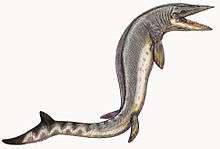Tylosaurinae
| Tylosaurines Temporal range: Late Cretaceous | |
|---|---|
 | |
| Tylosaurus nepaeolicus mounted skeleton in the Rocky Mountain Dinosaur Resource Center in Woodland Park, Colorado | |
| Scientific classification | |
| Kingdom: | Animalia |
| Phylum: | Chordata |
| Class: | Sauropsida |
| Order: | Squamata |
| Family: | Mosasauridae |
| Subfamily: | Tylosaurinae Williston, 1895[1] |
| Genera | |
Tylosaurinae [1][2] is a subfamily of mosasaurs, a diverse group of Late Cretaceous marine lizards.
Russell (1967, pp. 170 [3]) defined the Tylosaurinae as follows: "Large rostrum present anterior to premaxillary teeth. Twelve or more teeth in dentary and maxilla. Cranial nerves X, XI, and XII leave lateral wall of opisthotic through a single foramen. No canal in basioccipital or basispehnoid for basilar artery. Suprastapedial process of quadrate moderately large, distally pointed. Dorsal edge of surangular rounded and longitudinally horizontal...Twenty nine presacral vertebrae present. Length of presacral series less than that of postsacral series in Tylosaurus, neural spines of posterior caudal vertebrae at most only slightly elongated, do not form an appreciable fin. Haemal arches unfused to caudal centra. Appendicular elements lack smoothly finished articular surfaces."


Genera referrable to the Tylosaurinae (informally and collectively known as "tylosaurines" or "tylosaurs") have been found on all continents except Australia and South America. The etymology for the subfamily is derived from the genus of the type species, Tylosaurus. In general, tylosaurs were large-bodied marine lizards armed with sturdy, conical teeth and an elongated premaxilla and extensions of the dentaries that do not bear teeth to the very end such as is found in other genera of mosasaurs. Cope's original concept of a "battering ram" snout is not supported by fossil evidence. Stomach contents from a tylosaur recovered in South Dakota[4] included remains of another mosasaur, a bony fish, the large, flightless seabird Hesperornis, and possibly a shark, indicating that tylosaurs were generalists. Another specimen collected by Charles Sternberg [5] included the bones of a small plesiosaur (see also [6]).
Lingham-Soliar [7] suggested that tylosaurines were not among the fastest swimming nor the strongest mosasaurids. However, they are lightly built, having greatly reduced the weight of their bodies and possessing relatively small pectoral and pelvic girdles, fore- and hindlimbs. Their bone is highly cancellous and may have been impregated with fat cells during life, adding buoyancy. These traits suggest that tylosaurs may have been ambush predators. Tylosaurs were among the largest mosasaurs, with some species of Tylosaurus and Hainosaurus reaching lengths of 9-15+ meters, making them among the largest of all marine reptiles. Everhart [8] erected a third species, T. kansasensis, from the Smoky Hill Chalk, but subsequent study has found T. kansasensis to be a growth stage of T. nepaeolicus and therefore the same species.[9]
Polcyn and Bell (2005, p. 322 [10]) have erected a more inclusive clade, the parafamily Russellosaurina, which includes the "subfamilies Tylosaurinae and Plioplatecarpinae and their sister-clade containing the genera Tethysaurus, Russellosaurus, and Yaguarasaurus."
Tylosaurs first appear in the fossil record in the early Coniacian [11] and persist well into the Maastrichtian, a period of approximately twenty million years.
Species and Taxonomy
- Tylosaurinae
- Tylosaurus
- T. proriger
- T. nepaeolicus (=T. kansasensis)
- T. pembinensis
- T. gaudryi
- Hainosaurus
- H. bernardi
- H. newmilleri
- Taniwhasaurus
- T. oweni (=Tylosaurus haumuriensis)
- T. mikasaensis
- T. antarcticus
- T. ivoensis[12]
- Tylosaurus
References
- 1 2 Williston, S. W. 1895. New or little-known extinct vertebrates. Kansas University Quarterly 6:95-98.
- ↑ Williston, S. W. 1897. Range and distribution of the mosasaurs with remarks on synonymy. Kansas University Quarterly 4(4):177-185.
- ↑ Russell DA, 1967. Systematics and morphology of American mosasaurs. Peabody Museum of Natural History, Yale University, Bulletin 23.
- ↑ Martin JE, Bjork PR. 1987. Gastric residues associated with a mosasaur from the late Cretaceous (Campanian) Pierre Shale in South Dakota. Dakoterra 3:68-72.
- ↑ Sternberg CH. 1922. Explorations of the Permian of Texas and the chalk of Kansas, 1918. Transactions of the Kansas Academy of Science 30(1):119-120. (Papers - Fifty-first annual meeting, 1919), State Printer, Topeka.
- ↑ Everhart MJ. 2004. Plesiosaurs as the food of mosasaurs; new data on the stomach contents of a Tylosaurus proriger (Squamata; Mosasauridae) from the Niobrara Formation of western Kansas. The Mosasaur 7:41-46.
- ↑ Lingham-Soliar T. 1992. The tylosaurine mosasaurs (Reptilia, Mosasauridae) from the upper Cretaceous of Europe and Africa. Bulletin de L’Institut Royal des Sciences Naturelles de Belgique. Sciences de la Terre 62:171-194.
- ↑ Everhart MJ. 2005a. Tylosaurus kansasensis, a new species of tylosaurine (Squamata: Mosasauridae) from the Niobrara Chalk of western Kansas, U.S.A. Netherlands Journal of Geosciences / Geologie en Mijnbouw 84 (3): 231-240.
- ↑ Paulina Jiménez-Huidobro, Tiago R. Simões and Michael W. Caldwell (2016). "Re-characterization of Tylosaurus nepaeolicus (Cope, 1874) and Tylosaurus kansasensis Everhart, 2005: Ontogeny or sympatry?". Cretaceous Research. in press. doi:10.1016/j.cretres.2016.04.008.
- ↑ Polcyn MJ, Bell GL Jr. 2005. Russellosaurus coheni n. gen., n. sp., a 92 million-year-old mosasaur from Texas (USA), and the definition of the parafamily Russellosaurina. Netherlands Journal of Geosciences 84(3): 321-333.
- ↑ Everhart MJ. 2005b. Earliest record of the genus Tylosaurus (Squamata; Mosasauridae) from the Fort Hays Limestone (Lower Coniacian) of western Kansas. Transactions 108 (3/4): 149-155.
- ↑ Caldwell MW, Konishi T, Obata I, Muramoto K. 2008. New species of Taniwhasaurus (Mosasauridae, Tylosaurinae) from the upper Santonian-lower Campanian (Upper Cretaceous) of Hokkaido, Japan. Journal of Vertebrate Paleontology 28 (2): 339-348.
Further reading
- Bell, G. L. Jr., 1997. A phylogenetic revision of North American and Adriatic Mosasauroidea. pp. 293–332 In Callaway J. M. and E. L Nicholls, (eds.), Ancient Marine Reptiles, Academic Press, 501 pp.
- Lindgren, J. et. Siverson, M. 2002.Tylosaurus ivoensis: a giant mosasaur from the early Campanian of Sweden. Royal Society of Edinburgh Transactions: Earth Sciences Vol. 93(1):73-93.
- Russell, D. A. 1970. The vertebrate fauna of the Selma Formation of Alabama, Part VII, The mosasaurs, Fieldiana, Geology Memoirs 3(7):369-380.